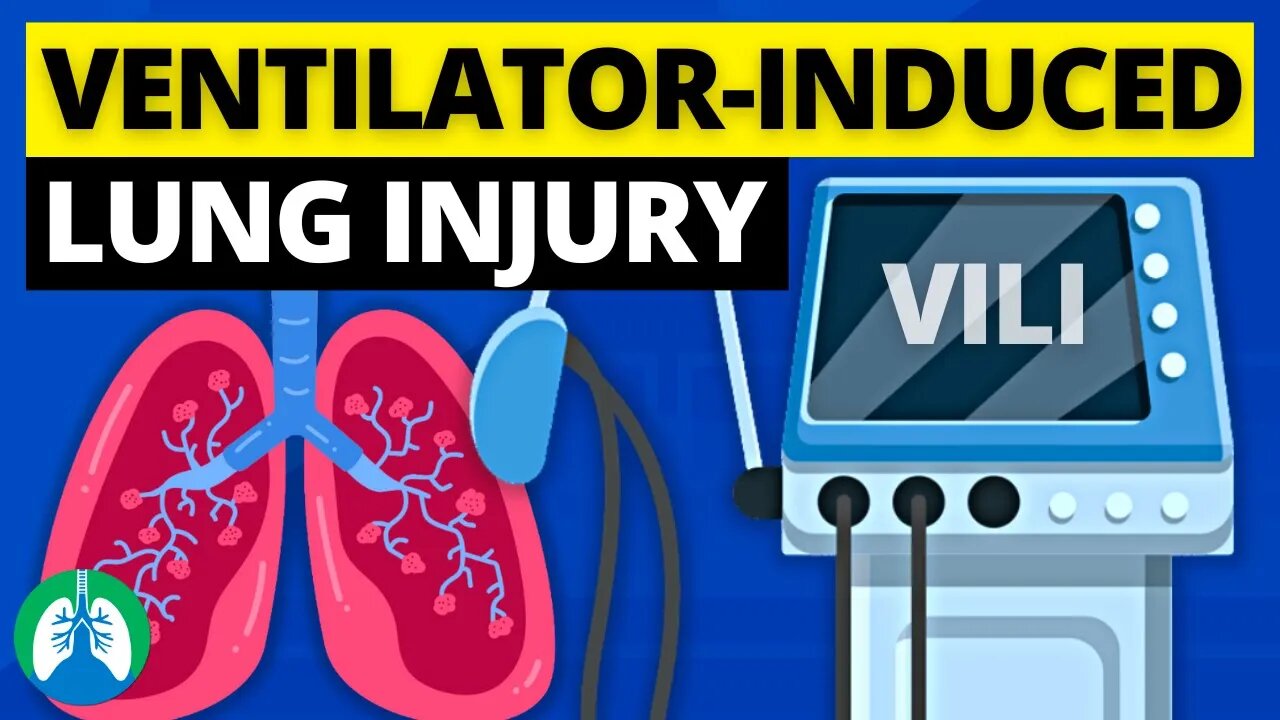Premium Only Content

Ventilator-Induced Lung Injury (VILI) | Quick Explainer Video
What is a Ventilator-Induced Lung Injury (VILI)? This video covers the medical definition and provides a brief overview of this topic.
💥Ventilator-Induced Lung Injury [Full Guide] ➜ ➜ ➜ http://bit.ly/3XowNju
💥Ventilator Settings [Full Guide] ➜ ➜ ➜ https://bit.ly/2KMrNle
It is caused by the mechanical forces associated with positive-pressure mechanical ventilation, which can cause damage to lung tissue.
➡️ Types:
- Barotrauma
- Volutrauma
Barotrauma is caused by high airway pressures that can cause a rupture of the alveoli or bronchi. Similarly, volutrauma is caused by high volumes of air being forced into small airways, which can cause lung tissue to stretch and damage. The symptoms of VILI range from mild dyspnea (shortness of breath) to severe respiratory distress. The longer a patient is on mechanical ventilation, the greater their chances are of experiencing this type of injury.
➡️ Lung Protective Strategies
- Smaller tidal volumes
- Low plateau pressures
- Low driving pressures
- Appropriate FiO2
- Appropriate levels of PEEP
These strategies are often used in patients with acute respiratory distress syndrome (ARDS), which is a disorder characterized by refractory hypoxemia, decreased lung compliance, and severe oxygen insufficiency. Ventilator-induced lung injuries are primarily caused by an increased transpulmonary pressure during positive-pressure ventilation. This pressure is the difference between alveolar pressure and pleural pressure.
When the transpulmonary pressure is increased, it can cause alveolar rupture and collapse of lung tissue. This explains why clinicians concluded that a lower transpulmonary pressure is associated with a lower risk of ventilator-induced lung injuries.
- Tidal volume 4–8 mL/kg
- Plateau Pressure less than 28 cmH2O
- Driving pressure less than 15 cmH2O
- FiO2 to maintain PaO2 55–80 mmHg
- FiO2 to maintain SpO2 88–95%
💥Ventilator-Induced Lung Injury [Full Guide] ➜ ➜ ➜ http://bit.ly/3XowNju
💥Ventilator Settings [Full Guide] ➜ ➜ ➜ https://bit.ly/2KMrNle
—————
📗 BEST STUDY GUIDES FOR YOU
▪ TMC Test Bank 👉 http://bit.ly/2IGeqSu
▪ Hacking the TMC Exam 👉 http://bit.ly/2XBc8do
▪ TMC Exam Bundle (Save $) 👉 https://bit.ly/34pqEsV
▪ Daily TMC Practice Questions 👉 http://bit.ly/2NnXh3C
💙MORE FROM RTZ
▪ Free TMC Practice Exam 👉 http://bit.ly/2XlwASL
▪ Free RRT Cheat Sheet 👉 http://bit.ly/2IbmOKB
▪ Resources for RT's 👉 http://bit.ly/2WVV5qo
▪ Testimonials 👉 http://bit.ly/2x7b5Gl
🌐FOLLOW US
▪ Instagram 👉 http://bit.ly/2FhF0jV
▪ Twitter 👉 http://bit.ly/2ZsS6T1
▪ Facebook 👉 http://bit.ly/2MSEejt
▪ Pinterest 👉 http://bit.ly/2ZwVLPw
🚑MEDICAL DISCLAIMER
This content is for educational and informational purposes only. It is not intended to be a substitute for professional medical advice, diagnosis, or treatment. Please consult with a physician with any questions that you may have regarding a medical condition. Never disregard professional medical advice or delay in seeking it because of something you watch in this video. We strive for 100% accuracy, but errors may occur, and medications, protocols, and treatment methods may change over time.
💡AFFILIATE DISCLAIMER
This description contains affiliate links. If you decide to purchase a product through one of them, we receive a small commission at no cost to you.
—————
⏰TIMESTAMPS
0:00 - Intro
0:18 - Types
1:00 - Lung Protective Strategies
—————
🖼CREDIT FOR MUSIC AND GRAPHICS:
▪ Music licensed from Audiojungle.net/
▪ Graphics: Canva.com, Freevector.com, Vecteezy.com, and Pngtree.com
#mechanicalventilation #RespiratoryTherapy #RespiratoryTherapist
-
 3:17
3:17
Respiratory Therapy Zone
1 year agoWhat is Silicosis? (EXPLAINED) 🫁
417 -
 3:03:27
3:03:27
vivafrei
22 hours agoEp. 242: Barnes is BACK AGAIN! Trump, Fani, J6, RFK, Chip Roy, USS Liberty AND MORE! Viva & Barnes
185K199 -
 8:09:50
8:09:50
Dr Disrespect
20 hours ago🔴LIVE - DR DISRESPECT - MARVEL RIVALS - GOLD VANGUARD
206K33 -
 1:15:00
1:15:00
Awaken With JP
19 hours agoMerry Christmas NOT Happy Holidays! Special - LIES Ep 71
245K206 -
 1:42:21
1:42:21
The Quartering
20 hours agoTrump To INVADE Mexico, Take Back Panama Canal Too! NYC Human Torch & Matt Gaetz Report Drops!
183K111 -
 2:23:15
2:23:15
Nerdrotic
20 hours ago $15.02 earnedA Very Merry Christmas | FNT Square Up - Nerdrotic Nooner 453
137K13 -
 1:14:05
1:14:05
Tucker Carlson
19 hours ago“I’ll Win With or Without You,” Teamsters Union President Reveals Kamala Harris’s Famous Last Words
238K386 -
 1:58:31
1:58:31
The Dilley Show
19 hours ago $37.24 earnedTrump Conquering Western Hemisphere? w/Author Brenden Dilley 12/23/2024
176K50 -
 1:09:59
1:09:59
Geeks + Gamers
20 hours agoSonic 3 DESTROYS Mufasa And Disney, Naughty Dog Actress SLAMS Gamers Over Intergalactic
120K21 -
 51:59
51:59
The Dan Bongino Show
21 hours agoDemocrat Donor Admits The Scary Truth (Ep. 2393) - 12/23/2024
950K3.19K